Dynamic Robustness of Semantic-Based Collaborative Knowledge Network of Open Source Project
Abstract
1. Introduction
2. Construction of Weighted Collaborative Knowledge Network
2.1. Semantic-Based Weight Calculation
- Word segmentation: Take all collaborative content contained in the community project as the target text, then take punctuation marks and stop words as word segmentation intervals to obtain a candidate set of text keywords, .
- Construct the co-occurrence matrix, as shown in Equation (2):where is the frequency of the occurrence of the candidate word in the text, and is the frequency of the co-occurrence of the candidate words tm and tn in the same phrase.
- Calculate candidate word weight: According to the co-occurrence matrix, get the degree of candidate word : , the frequency of candidate word : then use their ratio to represent the weight of the candidate word as shown in Formula (3):
- 4
- Calculate the content intensity of each designer: Follow step (1) to segment the overall comment content of each designer in the project to obtain a set of keyword candidates for each designer, , then calculate as the sum of the weights of the keywords contained in the designer comment text, as shown in Formula (4):where is the keyword set, is the candidate word set of designer i, and is the keyword contained in designer i. For example, Table 3 shows a list of the top ten nodes in the content intensity of an open source car community.
- 5
- Obtain by normalizing .
2.2. Network Structure Characteristics in Different Life Cycle Stages
3. Robustness Evaluation Index
3.1. Relative Size of Network Connectivity S
3.2. Relative Size of Collaborative Knowledge Efficiency H
4. Failure Mode Design of the Robustness Analysis
5. Dynamic Robustness Analysis Experiments
5.1. Robustness Analysis during Project Start-Up Stage
5.2. Robustness Analysis during Project Growth Stage
5.3. Robustness Analysis during Project Maturation Stage
- In the start-up, growth and maturation stages of network evolution, the CKN shows (a) low robustness in the face of regular failure of knowledge contribution behavior and high robustness in the face of irregular failure of knowledge contribution behavior, and (b) low robustness in the face of collective failure of knowledge contribution behavior and high robustness in the face of successive failure of knowledge contribution behavior.
- During the four regular failure modes (WS, WC, BS, BC), the network’s growth and maturation stages are affected differently. In the growth stage, the robustness of the CKN is lowest during the collective failure of knowledge contribution behavior mode (WC) and highest during the successive failure of knowledge dissemination behavior mode (BS). In the maturation stage, the robustness of the CKN is lowest during the collective failure of knowledge dissemination behavior mode (BC) and highest during the successive failure of knowledge contribution behavior mode (WS).
5.4. Robustness Analysis of the Network Facing the Same Behavior Failure Mode in Different Stages
6. Conclusions
- During the development of an OSP, network robustness trends from weak to strong. Therefore, community managers should pay more attention to network protection during the start-up period of the project. In particular, here it is necessary to introduce enough stable knowledge-contributing designers to avoid the decline of collaborative behavior. For example, in the start-up period of the project, we can invite well-known experts in the industry to participate in the discussion, which can not only improve the cooperation willingness of designers, but also improve the influence of the project, so that more followers can participate in the project cooperation.
- During the project growth stage, community managers should still focus on the protection of knowledge-contributing designers so as to avoid both the collective decline and successive decline of collaborative behaviors. For example, (1) more resource rights, advanced identity authentication, privilege level and other incentives could be given to designers with major knowledge contribution behavior to encourage them to participate further in knowledge collaboration. (2) Findings Trust, reciprocal benefits and enjoyment are significantly related to positive attitude toward knowledge sharing [52]. Therefore, the community needs to enhance the availability and reliability of the system to improve the collaborative willingness of knowledge contributing designers, For example, setting stars for high-quality knowledge shared by designers, establishing a case database for designers who actively participate in collaboration, and clearly stating the ownership of innovative knowledge in the community and terms of designers.
- During the maturation stage, more attention should be paid to the protection of knowledge-disseminating designers, including both the collective decline and successive decline of such designers’ cooperative behavior. For example, (1) reward and incentive measures should be given to these designers to increase their sense of belonging and achievement. (2) Enrich the entertainment functions and service functions of the community, such as setting up communication games, answering questions and one-to-one exclusive services, so as to improve the interest and pleasure of knowledge-disseminating.
Author Contributions
Funding
Institutional Review Board Statement
Informed Consent Statement
Data Availability Statement
Conflicts of Interest
Abbreviations
| CKN | Collaborative knowledge network |
| OSP | Open source project |
| OSC | Open source community |
| WS | Successive failure of knowledge contribution behavior |
| WC | Collective failure of knowledge contribution behavior |
| BS | Successive failure of knowledge dissemination behavior |
| BC | Collective failure of knowledge dissemination behavior |
| R | Random failure |
References
- Fang, Y.H.; Chiu, C.M. In justice we trust: Exploring knowledge-sharing continuance intentions in virtual communities of practice. Comput. Hum. Behav. 2010, 26, 235–246. [Google Scholar] [CrossRef]
- Zhang, W.; Watts, S. Online communities as communities of practice: A case study. J. Knowl. Manag. 2008, 12, 55–71. [Google Scholar] [CrossRef]
- Pan, Y.; Xu, Y.C.; Wang, X.; Zhang, C.; Ling, H.; Lin, J. Integrating social networking support for dyadic knowledge exchange: A study in a virtual community of practice. Inf. Manag. 2015, 52, 61–70. [Google Scholar] [CrossRef]
- O’Mahony, S. Guarding the commons: How community managed software projects protect their work. Res. Policy 2003, 32, 1179–1198. [Google Scholar] [CrossRef]
- Rashid, M.; Clarke, P.M.; O’Connor, R.V. A systematic examination of knowledge loss in open source software projects. Int. J. Inf. Manag. 2019, 46, 104–123. [Google Scholar] [CrossRef]
- Midha, V.; Palvia, P. Factors affecting the success of Open Source Software. J. Syst. Softw. 2012, 85, 895–905. [Google Scholar] [CrossRef]
- Griffith, T.L.; Sawyer, R.E. Multilevel knowledge and team performance. J. Organ. Behav. 2010, 31, 1003–1031. [Google Scholar] [CrossRef]
- Singh, P.; Tan, Y.; Mookerjee, Y. Network Effects: The Influence of Structural Capital on Open Source Project Success. Manag. Inf. Syst. Q. 2011, 35, 813. [Google Scholar] [CrossRef]
- Xingpei, J.; Wang, B.; Liu, D.; Guo, C.; Tang, F.; Wei, D.; Tu, L. Improving interdependent networks robustness by adding connectivity links. Phys. A Stat. Mech. Its Appl. 2016, 444, 9–19. [Google Scholar] [CrossRef]
- Martinez-Torres, M.R. A genetic search of patterns of behavior in OSS communities. Expert Syst. Appl. 2012, 39, 13182–13192. [Google Scholar] [CrossRef]
- Von Krogh, G.; Haefliger, S.; Spaeth, S.; Wallin, M.W. Carrots and Rainbows: Motivation and Social Practice in Open Source Software Development. Mis Q. 2012, 36, 649–676. [Google Scholar] [CrossRef]
- Zhou, H.-L.; Zhang, X.-D.; Hu, Y. Dynamic robustness of knowledge collaboration network of open source product development community. Phys. A Stat. Mech. Its Appl. 2018, 490, 601–612. [Google Scholar] [CrossRef]
- Zhou, H.; Zhang, X.; Hu, Y. Robustness of open source product innovation community’s knowledge collaboration network under the dynamic environment. Phys. A Stat. Mech. Its Appl. 2020, 540, 122888. [Google Scholar] [CrossRef]
- Fuge, M.; Agogino, A. How Online Design Communities Evolve Over Time: The Birth and Growth of OpenIDEO. In Proceedings of the ASME International Design Engineering Technical Conference, Buffalo, NY, USA, 17–20 August 2014; pp. 7–10. [Google Scholar] [CrossRef]
- Martinez-Torres, M.R. Analysis of activity in open-source communities using social network analysis techniques. Asian J. Technol. Innov. 2014, 22, 114–130. [Google Scholar] [CrossRef]
- Mockus, A. Two case studies of open source software development: Apache and Mozilla. ACM Trans. Softw. Eng. Methodol. 2002, 11, 309–346. [Google Scholar] [CrossRef]
- Bellingeri, M.; Cassi, D. Robustness of weighted networks. Phys. A Stat. Mech. Its Appl. 2018, 489, 47–55. [Google Scholar] [CrossRef]
- Bai, Y.; Deng, G.S. Social Network Link Prediction Based on User Interaction Weighted Graph. J. Chin. Comput. Syst. 2018, 39, 1988–1992. [Google Scholar]
- Xu, B.C.; Zhang, X.D. Opinion leader identification and following effect simulation in the open source community. Inf. Stud. Theory Appl. 2019, 42, 101–107. [Google Scholar] [CrossRef]
- Li, M.; Fan, Y.; Chen, J. Weighted networks of scientific communication: The measurement and geometrical role of weight. Phys. A Stat. Mech. Its Appl. 2005, 350, 643–656. [Google Scholar] [CrossRef]
- Toral, S.L.; Martinez-Torres, M.R.; Barrero, F. Analysis of virtual communities supporting OSS projects using social network analysis. Inf. Softw. Technol. 2010, 52, 296–303. [Google Scholar] [CrossRef]
- Adolfo Ordaz-Padilla, L.; Pena-Gallardo, R.; Alberto Morales-Saldana, J. A Robustness Study of Power System Stabilizers using Dynamic Modeling. IEEE Latin. Am. Trans. 2019, 17, 513–519. [Google Scholar] [CrossRef]
- Brandon-Jones, E.; Squire, B.; Autry, C.W. A Contingent Resource-Based Perspective of Supply Chain Resilience and Robustness. J. Supply Chain Manag. 2014, 50, 55–73. [Google Scholar] [CrossRef]
- Xu, Z.; Harriss, R. Exploring the structure of the U.S. intercity passenger air transportation network: A weighted complex network approach. GeoJournal 2013, 73, 87–102. [Google Scholar] [CrossRef]
- Albert, R.; Jeong, H.; Barabsi, A.L. Error and attack tolerance of complex networks. Nature 2000, 406, 378–382. [Google Scholar] [CrossRef]
- Holme, P.; Kim, B.J.; Yoon, C.N.; Han, S.K. Attack vulnerability of complex networks. Phys. Rev. E Stat. Nonlinear Soft Matter. Phys. 2002, 65, 56109. [Google Scholar] [CrossRef]
- Duan, D.L.; Lv, C.C.; Si, S.B. Dynamical robustness of networks against multi-node attacked. Phys. A Stat. Mech. Its Appl. 2017, 471, 837–844. [Google Scholar] [CrossRef]
- Penta, A. Robust dynamic implementation. J. Econ. Theory 2015, 160, 280–316. [Google Scholar] [CrossRef]
- He, Z.; Liu, S.; Zhan, M. Dynamical robustness analysis of weighted complex networks. Phys. A Stat. Mech. Its Appl. 2013, 392, 4181–4191. [Google Scholar] [CrossRef]
- Gallos, L.K.; Argyrakis, P.; Bunde, A.; Cohen, R.; Havlin, S. Tolerance of scale-free networks: From friendly to intentional attack strategies. Phys. A Stat. Mech. Its Appl. 2004, 344, 504–509. [Google Scholar] [CrossRef]
- Frank, S.; Pavlin, M.; Adrian, M.S.; David, G. Modeling User Reputation in Online Social Networks: The Role of Costs, Benefifits, and Reciprocity. Entropy 2020, 22, 1073. [Google Scholar] [CrossRef]
- Tanaka, G.; Morino, K.; Aihara, K. Dynamical robustness in complex networks: The crucial role of low-degree nodes. Sci. Rep. 2012, 2, 232. [Google Scholar] [CrossRef]
- Zhang, X.; Zhou, H.; Hu, Y. Dynamic robustness of knowledge collaborative network under mass collaboration environment. Comput. Integr. Manuf. Syst. C 2017, 23, 2353–2360. [Google Scholar] [CrossRef]
- Fuge, M.; Tee, K.; Agogino, A.; Maton, N. Analysis of Collaborative Design Networks: A Case Study of OpenIDEO. J. Comput. Inf. Sci. Eng. 2014, 14, 226–235. [Google Scholar] [CrossRef]
- Tang, Y.; Liao, H. On the robustness of regional collaborative innovation network structure. Value Eng. 2016, 81–83. [Google Scholar] [CrossRef]
- Tanizawa, T.; Paul, G.; Havlin, S.; Stanley, H.E. Optimization of the robustness of multimodal networks. Phys. Rev. E Stat. Nonlinear Soft Matter Phys. 2006, 74.016125. [Google Scholar] [CrossRef]
- Crucitti, P.; Latora, V.; Marchiori, M. A topological analysis of the Italian electric power grid. Phys. A Stat. Mech. Its Appl. 2004, 338, 92–97. [Google Scholar] [CrossRef]
- Mihalcea, R.; Tarau, P. TextRank: Bringing Order into Texts. In Proceedings of the Conference on Empirical Methods in Natural Language Processing, Barcelona, Spain, 25–26 July 2004; pp. 404–411. [Google Scholar]
- Liu, L.; Meng, K.; Dong, Z. Robustness of networks formed from interdependent correlated networks under intentional attacks. Phys. A Stat. Mech. Its Appl. 2018, 491, 329–339. [Google Scholar] [CrossRef]
- Rajaeian, M.M.; Cater-Steel, A.; Lane, M. Determinants of effective knowledge transfer from academic researchers to industry practitioners. J. Eng. Technol. Manag. 2018, 47, 37–52. [Google Scholar] [CrossRef]
- Guan, T.; Wang, L.; Jin, J.H.; Song, X.L. Knowledge contribution behavior in online Q&A communities: An empirical investigation. Comput. Hum. Behav. 2018, 81, 137–147. [Google Scholar] [CrossRef]
- Perkmann, M.; Tartari, V.; Mckelvey, M.; Autio, E.; Broström, A.; Este, P.D.; Fini, R.; Geuna, A.; Grimaldi, R.; Hughes, A.; et al. Academic engagement and commercialisation: A review of the literature on university–industry relation. Res. Policy 2013, 42, 423–442. [Google Scholar] [CrossRef]
- Rose, S.; Engel, D.; Cramer, N.; Cowley, W. Automatic Keyword Extraction from Individual Documents; John Wiley & Sons, Ltd.: Hoboken, NJ, USA, 2010. [Google Scholar]
- Wang, P.; Ai, S.Z. The game analysis of virtual community knowledge sharing based on the life cycle. Chin. J. Manag. Sci. 2016, 24, 74–80. [Google Scholar]
- Palloff, R. Building Learning Communities in Cyberspace. Community Coll. Rev. 2000, 27, 76–78. [Google Scholar] [CrossRef]
- Moingeon, B.; Quélin, B.; Dalsace, F.; Lumineau, F. Inter-Organizational Communities of Practice: Specificities and Stakes. Cah. Rech. 2012, 857, 18. [Google Scholar]
- Tan, C.; Guo, Y.; Wang, Y.; Zeng, Y. Game study on the choice of scientific research cooperative behavior in virtual academic community from the perspective of life cycle. Mod. Inf. 2020, 40, 51–57. [Google Scholar] [CrossRef]
- Davis, G.F.; Yoo, M.; Baker, W.E. The Small World of the American Corporate Elite, 1982–2001. Acoust. Speech Signal Process. Newsl. IEEE 2003, 1, 301–326. [Google Scholar] [CrossRef]
- Crucitti, P.; Latora, V.; Marchiori, M.; Rapisarda, A. Efficiency of scale-free networks: Error and attack tolerance. Phys. A Stat. Mech. Its Appl. 2012, 320, 622–642. [Google Scholar] [CrossRef]
- Wang, J.; Wu, X.; Chen, Y. Invulnerability simulation of weighted complex networks with different information. J. Cent. South Univ. (Sci. Technol.) 2013, 44, 1888–1893. [Google Scholar]
- Zhu, J.; Mauro, J.; Pramanick, I. Robustness benchmarking for hardware maintenance events. In Proceedings of the International Conference on Dependable Systems & Networks, San Francisco, CA, USA, 22–25 June 2003; pp. 115–122. [Google Scholar] [CrossRef]
- Killingsworth, B.; Xue, Y.; Liu, Y. Factors influencing knowledge sharing among global virtual teams. Team Perform. Manag. 2016, 22, 284–300. [Google Scholar] [CrossRef]
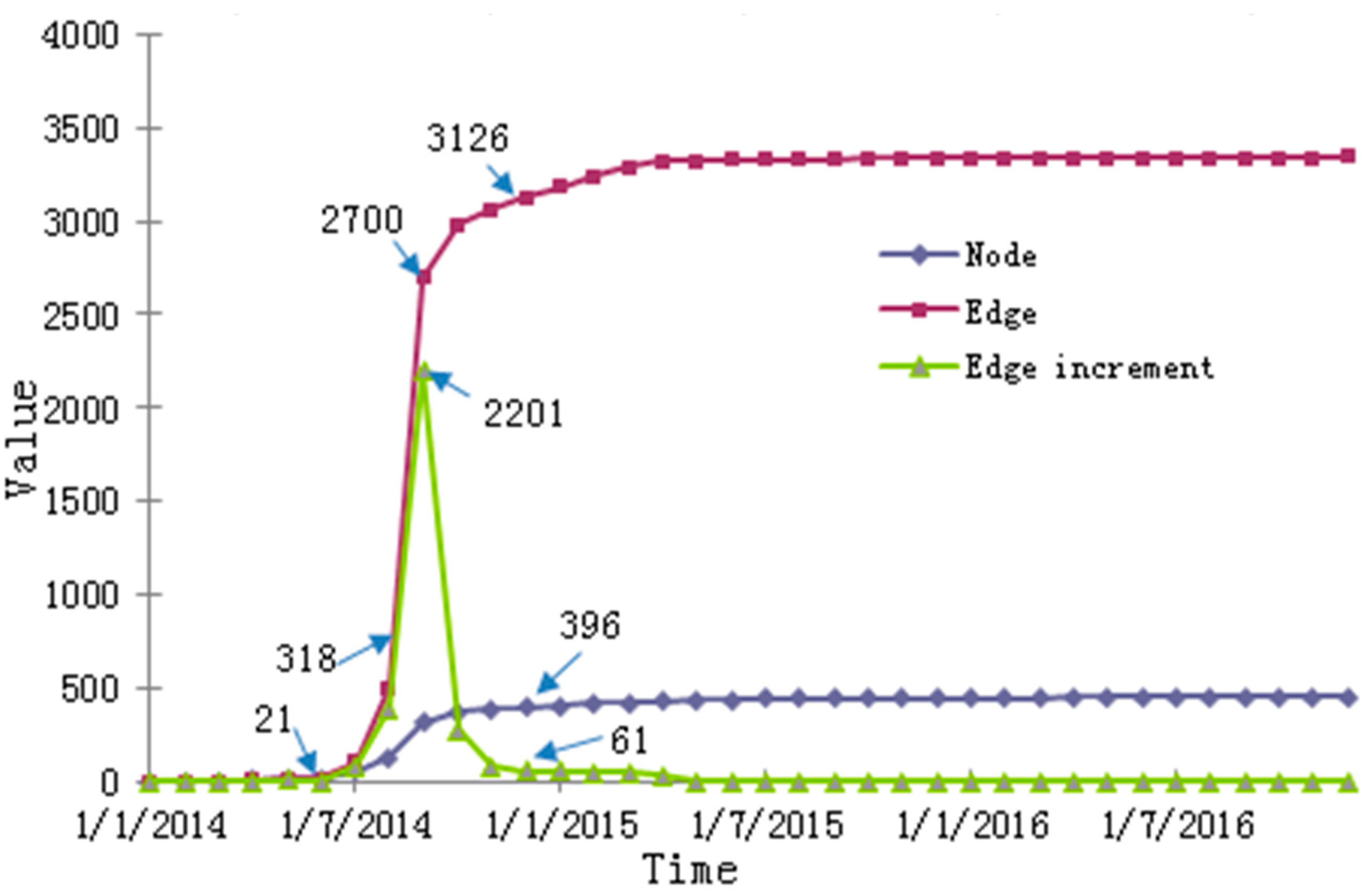
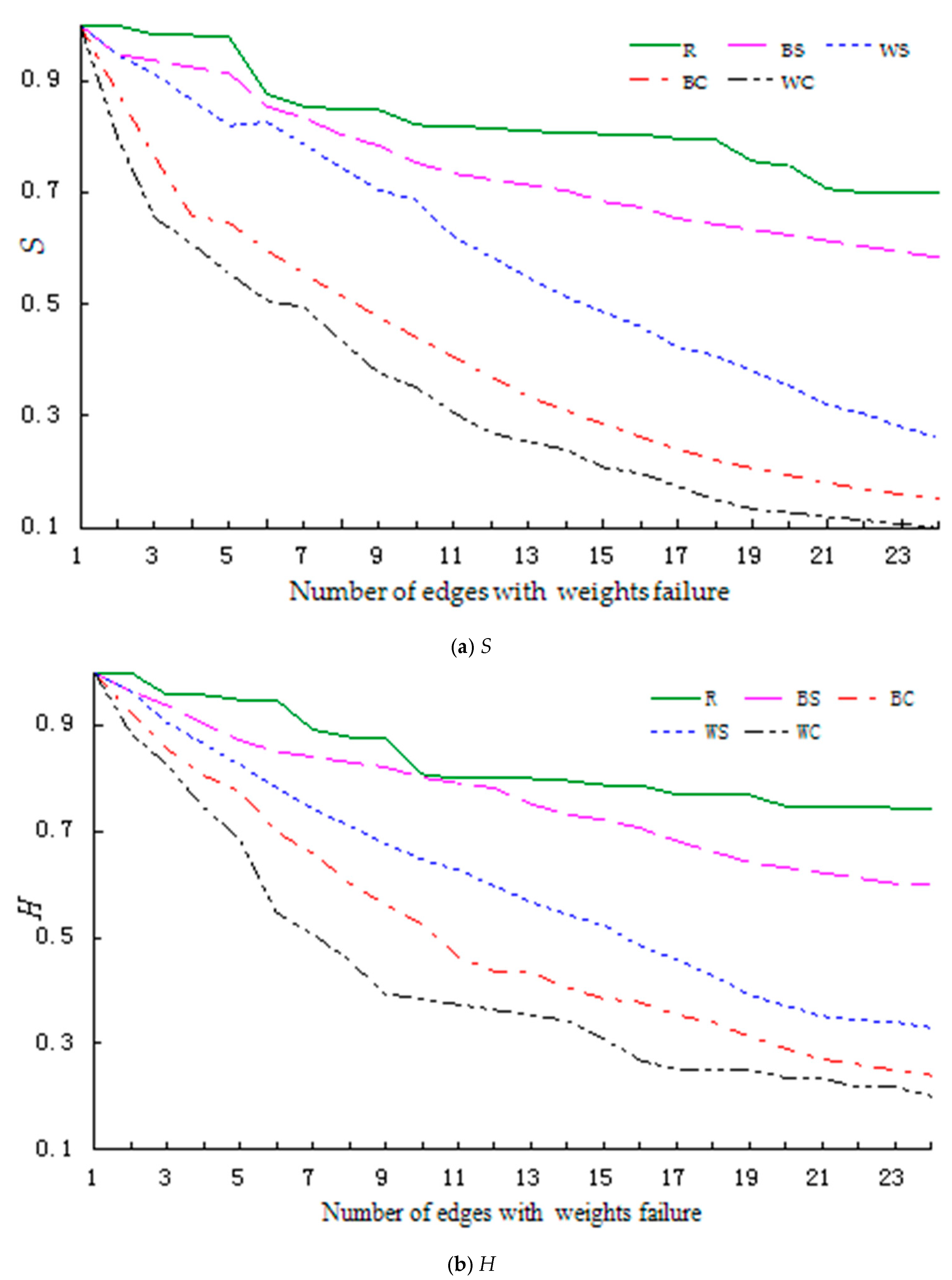
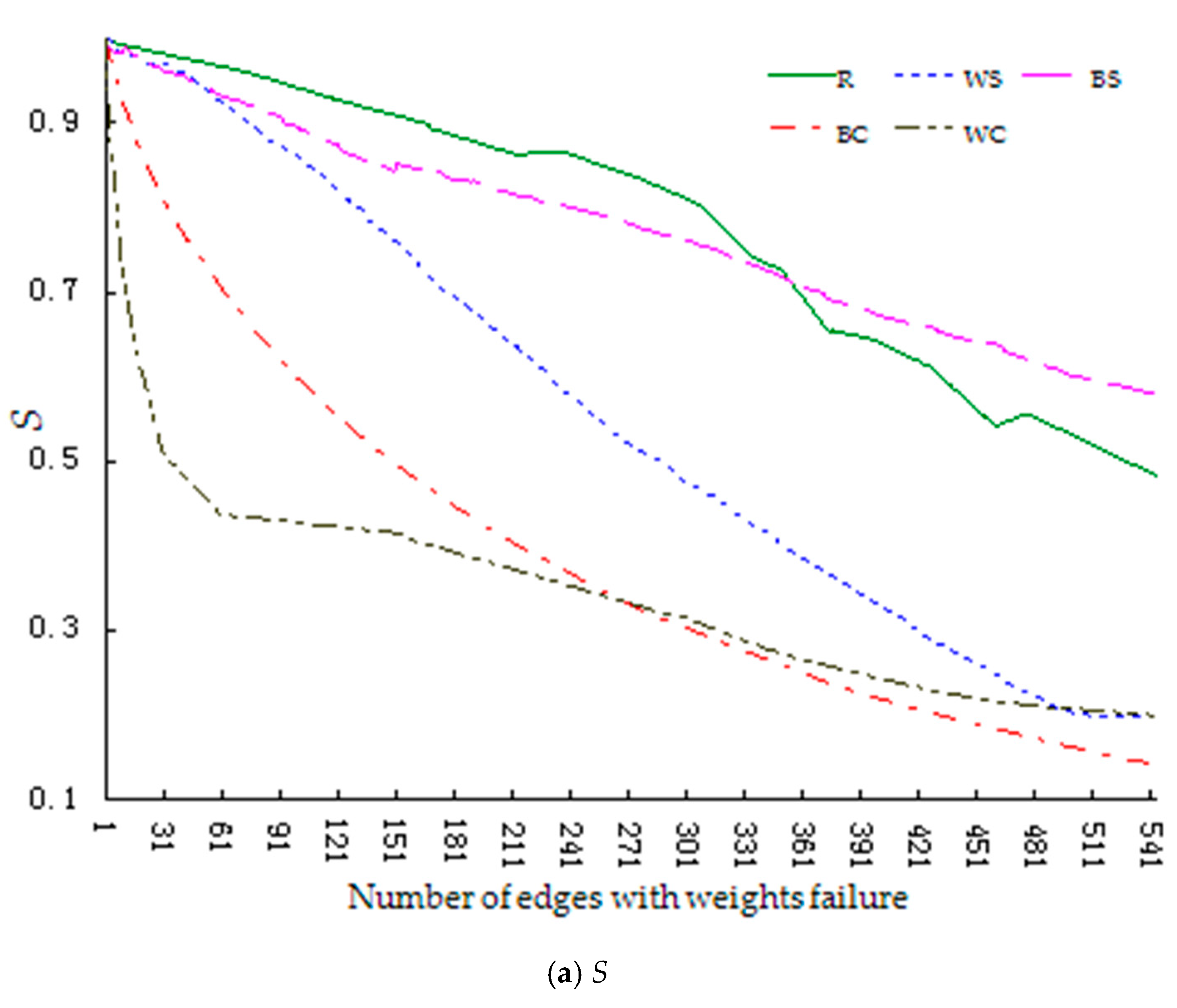

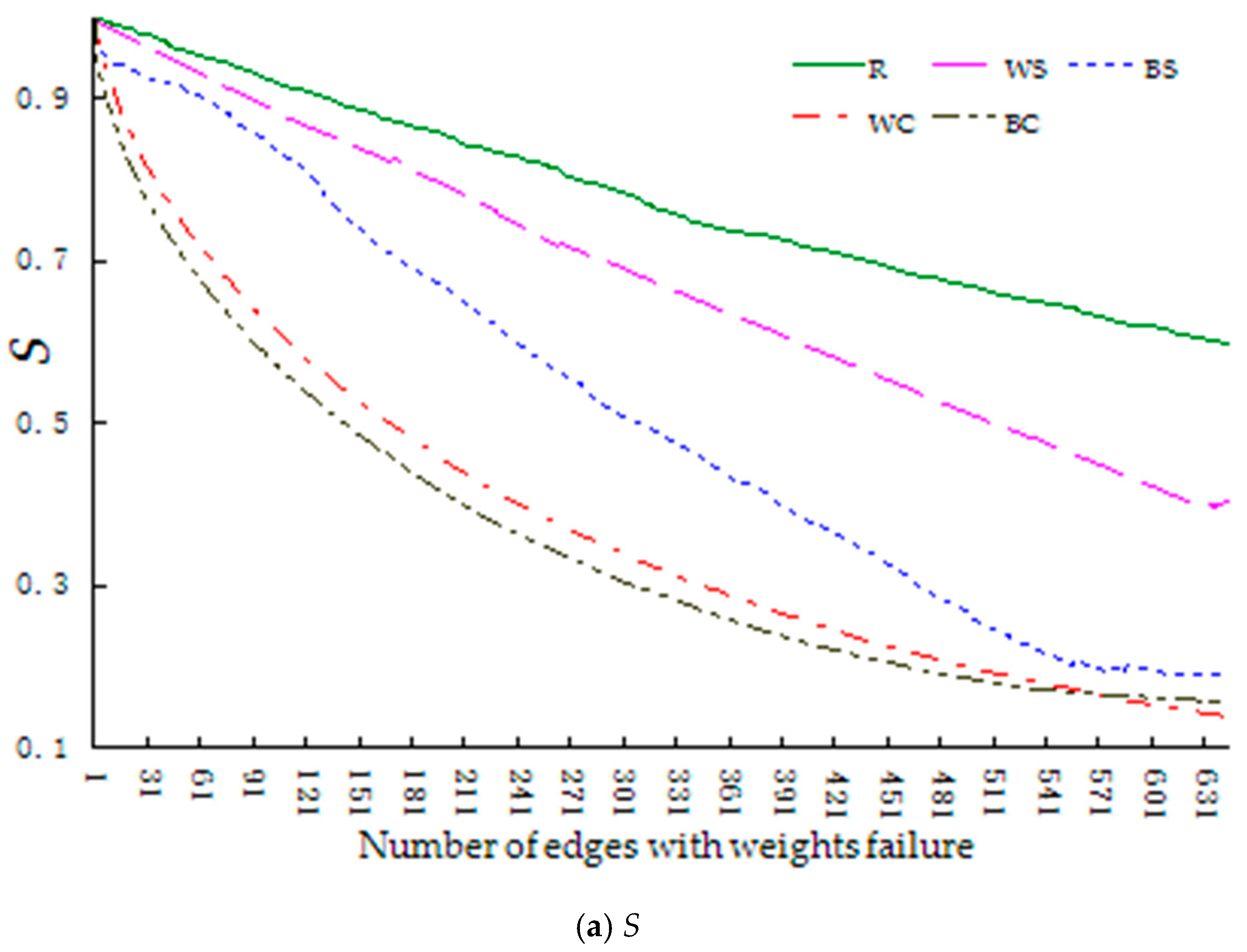
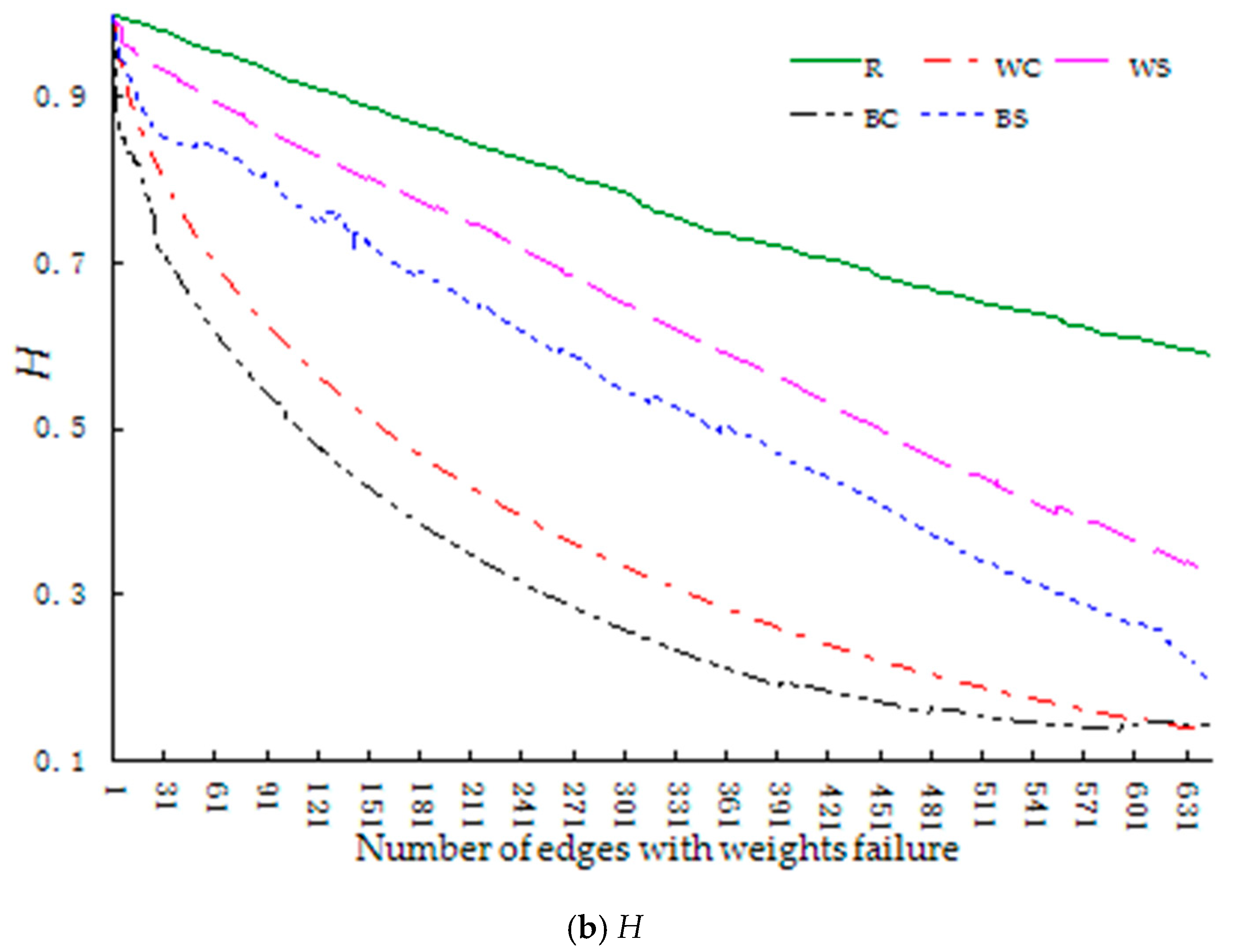
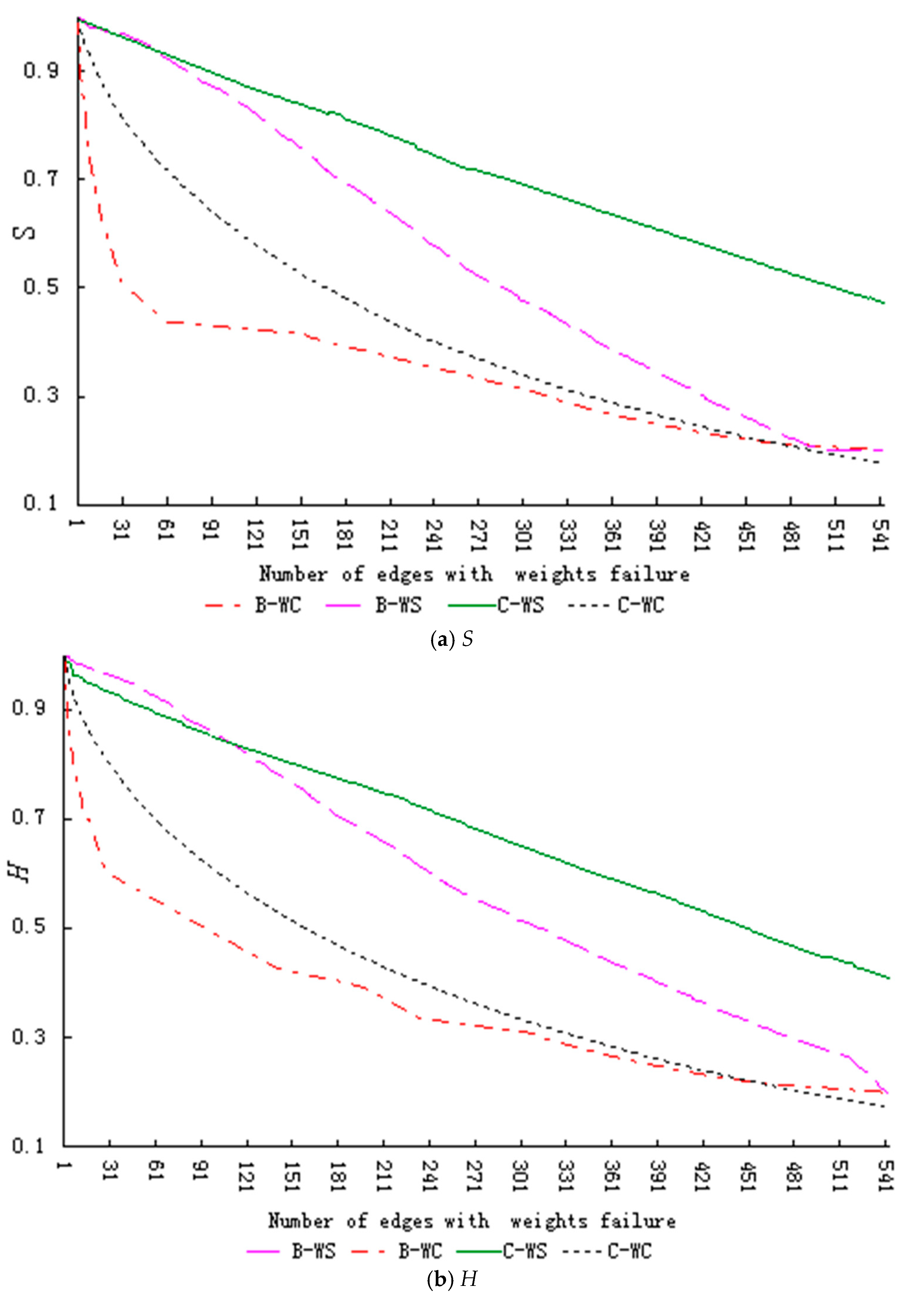
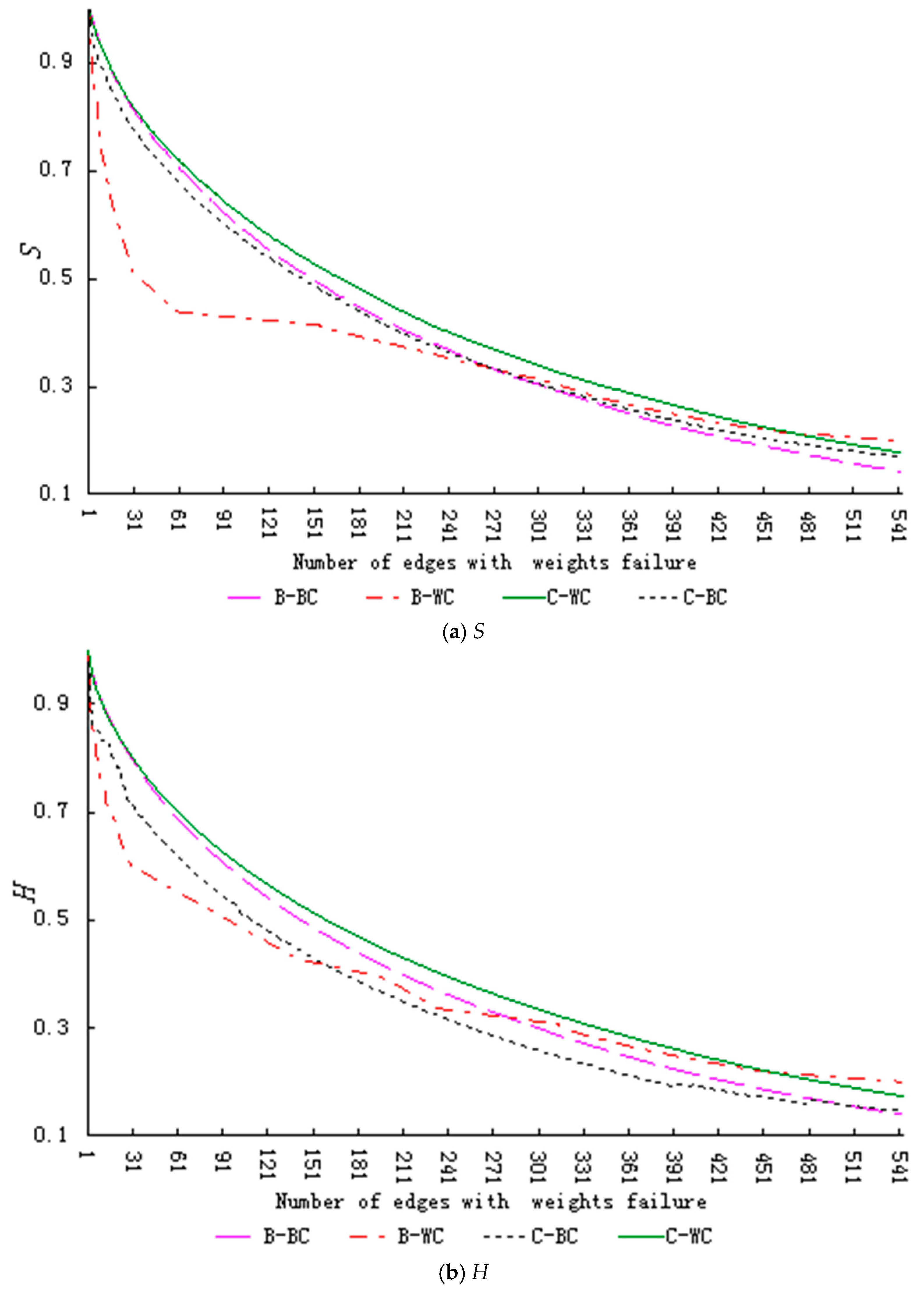
| Researcher (Time) | Network Model | Network Failure Mode | Robustness Measurement | Dynamic Evolution Stage |
|---|---|---|---|---|
| Zhou, H.; Zhang, X.; Hu, Y. (2020) | Collaborative knowledge network: user as nodes, frequency of communication as the weight. | Node failure based on: recalculate degree, recalculate betweenness, and random. | The relative size of the largest connected component, et al. | Three different stages of network development (i.e., the start-up, growth and maturation stages) |
| Martinez-Torres, M.R. (2014) | Weighted network: community members as nodes, number of e-mails as the weight. | One stage | ||
| Bellingeri, M.; Cassi, D. (2017) | The co-authorship network of scientists working on network theory and experiment: authors as nodes, the number of common papers and the number of authors of these papers as the weight. | Node failure based on: nearest neighbors (First), next to nearest neighbors (Sec) et al. | The size of the largest connected component (LCC), The weighted efficiency. | |
| Bai, Y.; Deng, G.S. (2016) | User Interaction weighted network: user as nodes, the number of forwarded interactions between nodes as the weight. | One stage | ||
| Duan, D.L.; Lv, C.C.; (2017) | Weighted network | A fraction node failure based on random. | Critical threshold against cascading failures | One stage |
| He, Z.; Liu, S.; Zhan, M. (2013) | Unweighted heterogeneous networks and weighted heterogeneous networks | Node failure based on: high-degree, low-degree. | The sum of the degrees of inactive nodes | One stage |
| Frank, S; Pavlin, M. (2020) | Online Social Networks: directed networks of users and their followers (Unweighted) | Node failure based on: the cost-benefit relationship. | Lifetime of the core-periphery structure | One stage |
| Tanaka, G.; Morino, K.; Aihara, K. (2012) | Coupled oscillator networks: networks consisting of N oscillator nodes coupled by diffusive connections with fixed strength. | Node failure based on: lower degree, random. | Order parameter, Average of the oscillation, Amplitudes over all the oscillators in the phase synchronization state. | One stage |
| Zhang, X.D; Zhou, H.L. (2017) | Knowledge collaborative network: user as nodes and the collaborative relationship between user as edges | Node failure based on: initial degree, initial betweenness, recalculate degree, recalculate betweenness. | The relative size of the largest connected component, Network efficiency. | Three different stages of network development (i.e., the start-up, growth and maturation stages) |
| Tang, Y.G; Liao, H.J. (2016) | Regional collaborative innovation network(unweighted network): innovation subject as nodes and the cooperation relationship between innovation subjects as edges | Node failure based on the: comprehensive betweenness. | Average path length, The most connected subgraph. | One stage |
| Tanizawa, T.; Paul, G.; Havlin, S.; (2006) | Scale-free multimodal network: given values of the number of modes, the total number of nodes, and the average degree | Node failure based on: random, targeted node removal. | Analytical formulas. | One stage |
| Liu, L.; Meng, K. (2018) | Interdependent networks with correlated structure: two interdependency scenarios: conditional and redundant interaction modes. | Node failure based on: random, low-degree, high-degree. | Giant component size. | One stage |
| Our work | Semantic-based Collaborative Knowledge Network: designers as nodes, collaborative behavior among designers as edges, and collaborative text content intensity and collaborative frequency intensity as the edge weights. | Edge failure modes based on: (1) collective failure of knowledge contribution behavior, (2) successive failure of knowledge contribution behavior, (3) collective failure of knowledge dissemination behavior, and (4) successive failure of knowledge dissemination behavior. | Relative size of network connectivity, Relative size of collaborative knowledge efficiency. | Three different stages of the project life cycle: the start-up, growth and maturation stages. |
| Keyword tm | Car | Side View | Design | Engine | Track Width | Entry | Package View | Technical | Profile | Rear |
|---|---|---|---|---|---|---|---|---|---|---|
| weight | 0.998 | 0.978 | 0.974 | 0.969 | 0.941 | 0.886 | 0.883 | 0.877 | 0.838 | 0.801 |
| Nodei | 328 | 351 | 311 | 325 | 14 | 210 | 317 | 185 | 160 | 356 |
| 1210.57 | 871.7 | 811.53 | 370.21 | 311.72 | 267.6 | 260.6 | 257.47 | 218.57 | 203.53 |
| Network | Topological Parameter | Network Characteristic | |||||||
|---|---|---|---|---|---|---|---|---|---|
| Number of Nodes | Average Out-Degree | Average Path Length | Clustering Coefficient | Network Efficiency | Small World Parameter | Small World Characteristic | Scale Free Property | Assortatvity | |
| Start-up stage | 16 | 1.3529 | 2.0932 | 0.1261 | 0.2151 | 11.0804 | Yes | Yes | No |
| Growth stage | 318 | 7.9296 | 2.5445 | 0.3374 | 0.2877 | 19.3845 | Yes | Yes | No |
| Maturation stage | 419 | 7.3430 | 2.6403 | 0.3278 | 0.2630 | 23.1868 | Yes | Yes | No |
| Failure Mode Description | Failure Simulation Calculation Process | |
|---|---|---|
| Failure Mode of collaborative behavior | Successive failure of knowledge contribution behavior (WS) | Sort the edges generated by the network according to their weights, from large to small, where the weight of the edge with the largest weight is proportionally reduced according to the sorting result. Take the network at this time as the current network, then calculate the weight and sort to reduce the edge with the largest edge weight. Repeat n times to simulate the continuous failure of knowledge contribution behavior. |
| Collective failure of knowledge contribution behavior (WC) | Sort the edges generated by the network according to their weights, from large to small. Select the top n weights to connect the edges according to this sorting result, then reduce the weights by a certain percentage to simulate the collective failure of knowledge contribution behavior. | |
| Successive failure of knowledge dissemination behavior (BS) | Sort the edges generated by the network according to the order of edge betweenness, from large to small, where the edge weight of the edge with the largest edge betweenness is proportionally reduced. Take the network at this time as the current network, then calculate and sort the edge betweenness, where the edge weight with the largest edge betweenness is reduced and repeated N times to simulate the failure of knowledge dissemination behavior. | |
| Collective failure of knowledge dissemination behavior (BC) | Sort the edges generated by the network according to the order of edge betweenness, from large to small. Select the top n connected edges according to this sorting result, then reduce the weight of edges to simulate the collective failure of knowledge dissemination behavior. | |
| Random failure | Random failure (R) | Randomly select the edge generated by the network according to its weight, where the edge weight is reduced proportionally. |
| Pairing Failure Mode | M | SD | 95% Confidence Interval | t | df | Sig | ||
|---|---|---|---|---|---|---|---|---|
| Lower Limits | Upper Limits | |||||||
| R-BS | 0.084231 | 0.040326 | 0.067204 | 0.101262 | 10.233 | 23 | 0.000 | |
| S | BS-WS | 0.153952 | 0.107466 | 0.108573 | 0.199331 | 7.018 | 23 | 0.000 |
| WS-BC | 0.175503 | 0.058234 | 0.150913 | 0.200093 | 14.764 | 23 | 0.000 | |
| BC-WC | 0.072582 | 0.022999 | 0.062871 | 0.082294 | 15.460 | 23 | 0.000 | |
| R-BS | 0.071423 | 0.045057 | 0.052397 | 0.090449 | 7.766 | 23 | 0.000 | |
| H | BS-WS | 0.161813 | 0.091040 | 0.123370 | 0.200256 | 8.707 | 23 | 0.000 |
| WS-BC | 0.093761 | 0.038576 | 0.077471 | 0.110050 | 11.907 | 23 | 0.000 | |
| BC-WC | 0.0804623 | 0.045413 | 0.061286 | 0.099638 | 8.680 | 23 | 0.000 | |
| Pairing Failure Mode | M | SD | 95% Confidence Interval | t | df | Sig | ||
|---|---|---|---|---|---|---|---|---|
| Lower Limits | Upper Limits | |||||||
| R-BC | 0.013707 | 0.042816 | 0.010097 | 0.01731 | 7.46 | 542 | 0.001 | |
| S | BC-WS | 0.225036 | 0.135681 | 0.212829 | 0.237243 | 36.224 | 476 | 0.000 |
| WS-BC | 0.236496 | 0.053234 | 0.230437 | 0.242554 | 76.818 | 298 | 0.000 | |
| BC-WC | 0.072419 | 0.057574 | 0.065866 | 0.078971 | 21.75 | 298 | 0.000 | |
| R-BC | 0.006946 | 0.052469 | 0.002523 | 0.011369 | 3.085 | 542 | 0.002 | |
| H | BC-WS | 0.171703 | 0.125931 | 0.159653 | 0.183752 | 28.009 | 421 | 0.000 |
| WS-BC | 0.214288 | 0.053104 | 0.208294 | 0.220281 | 70.357 | 303 | 0.000 | |
| BC-WC | 0.111128 | 0.101701 | 0.099648 | 0.122607 | 19.05 | 303 | 0.000 | |
| Pairing Failure Mode | M | SD | 95% Confidence Interval | t | df | Sig | ||
|---|---|---|---|---|---|---|---|---|
| Lower Limits | Upper Limits | |||||||
| R-WS | 0.143179 | 0.065401 | 0.138122 | 0.148236 | 55.59 | 644 | 0.000 | |
| S | WS-BS | 0.086093 | 0.016223 | 0.084744 | 0.087442 | 125.358 | 557 | 0.000 |
| BS-WC | 0.181593 | 0.061437 | 0.175039 | 0.188147 | 54.501 | 339 | 0.000 | |
| WC-BC | 0.051196 | 0.005174 | 0.080188 | 0.082204 | 158.606 | 254 | 0.000 | |
| R-WS | 0.102239 | 0.058472 | 0.097718 | 0.106760 | 44.406 | 644 | 0.000 | |
| H | WS-BS | 0.133359 | 0.069257 | 0.127037 | 0.139889 | 41.731 | 467 | 0.000 |
| BS-WC | 0.182520 | 0.048358 | 0.177392 | 0.187648 | 70.003 | 343 | 0.000 | |
| WC-BC | 0.039459 | 0.003451 | 0.039073 | 0.039848 | 199.667 | 304 | 0.000 | |
| Pairing Failure Mode | M | SD | 95% Confidence Interval | t | df | Sig | ||
|---|---|---|---|---|---|---|---|---|
| Lower Limits | Upper Limits | |||||||
| B(WS)-C(WS) | −0.085595 | 0.073348 | −0.092194 | −0.07899 | −25.487 | 476 | 0.000 | |
| S | B(BC)-C(BC) | 0.059745 | 0.011397 | 0.058339 | 0.061151 | 83.711 | 254 | 0.000 |
| B(WC)-C(WC) | −0.09193 | 0.049134 | −0.09737 | −0.086483 | −33.207 | 314 | 0.000 | |
| B(WS)-C(WS) | −0.134390 | 0.095798 | −0.143556 | −0.125223 | −28.818 | 421 | 0.000 | |
| H | B(BC)-C(BC) | 0.014243 | 0.012625 | 0.012818 | 0.015668 | 19.670 | 303 | 0.000 |
| B(WC)-C(WC) | −0.13207 | 0.092625 | −0.142322 | −0.121818 | −25.347 | 315 | 0.000 | |
Publisher’s Note: MDPI stays neutral with regard to jurisdictional claims in published maps and institutional affiliations. |
© 2021 by the authors. Licensee MDPI, Basel, Switzerland. This article is an open access article distributed under the terms and conditions of the Creative Commons Attribution (CC BY) license (http://creativecommons.org/licenses/by/4.0/).
Share and Cite
Lei, S.; Zhang, X.; Xie, S.; Zheng, X. Dynamic Robustness of Semantic-Based Collaborative Knowledge Network of Open Source Project. Entropy 2021, 23, 391. https://doi.org/10.3390/e23040391
Lei S, Zhang X, Xie S, Zheng X. Dynamic Robustness of Semantic-Based Collaborative Knowledge Network of Open Source Project. Entropy. 2021; 23(4):391. https://doi.org/10.3390/e23040391
Chicago/Turabian StyleLei, Shaojuan, Xiaodong Zhang, Shilin Xie, and Xin Zheng. 2021. "Dynamic Robustness of Semantic-Based Collaborative Knowledge Network of Open Source Project" Entropy 23, no. 4: 391. https://doi.org/10.3390/e23040391
APA StyleLei, S., Zhang, X., Xie, S., & Zheng, X. (2021). Dynamic Robustness of Semantic-Based Collaborative Knowledge Network of Open Source Project. Entropy, 23(4), 391. https://doi.org/10.3390/e23040391







